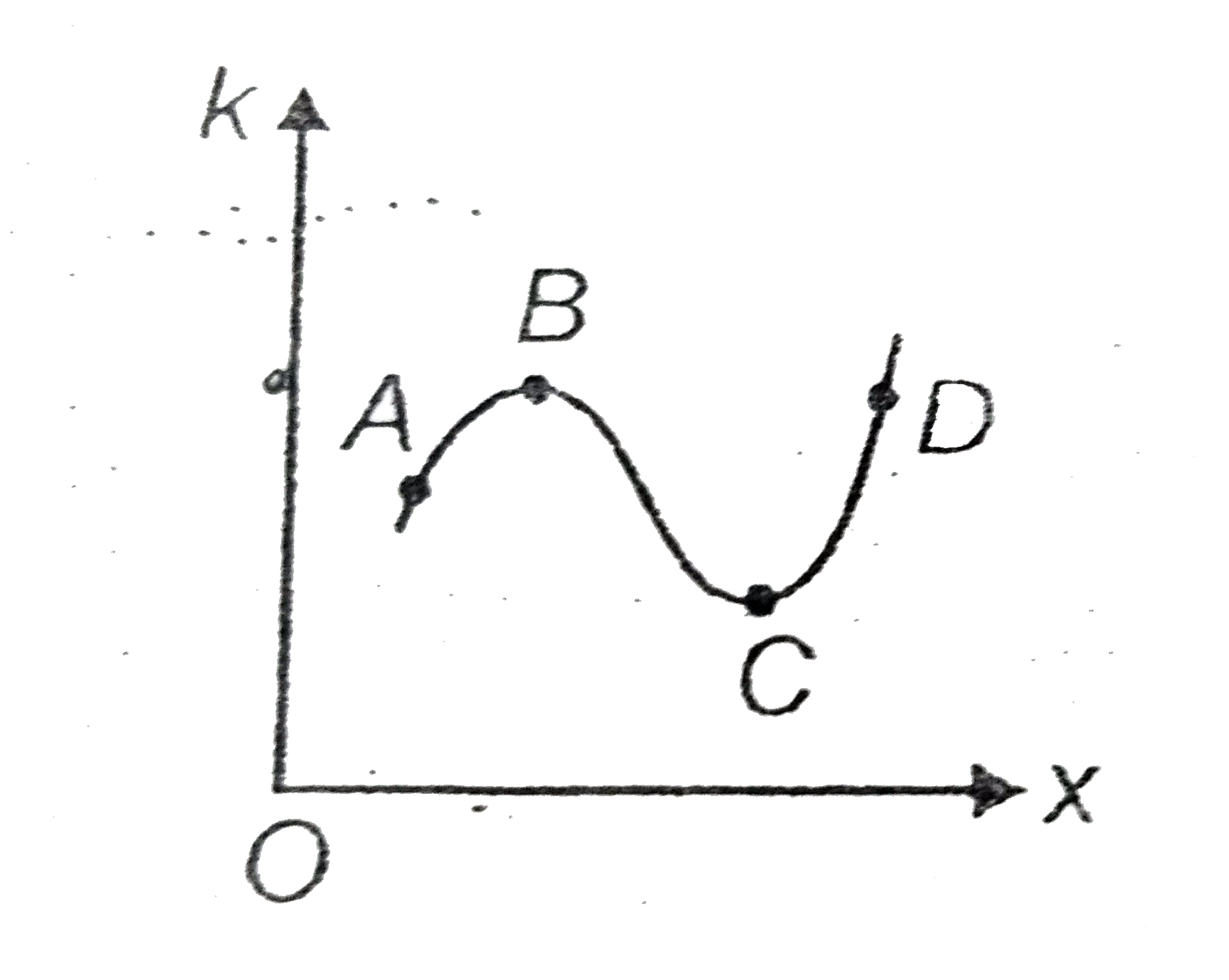Potential energy of a particle moving along x-axis under the action of only conservative force is given as U=10+4cos(4πx). Here, U is in Joule and x in metres. Total mechanial energy of the particle is 16 J. Choose the correct option.
At x = 1.25 m, particle is at equilibrium position
Maximum kinetic energy of the particle is 20 J
Both (a) and (b) are correct
Both (a) and (b) and wrong
The correct Answer is:A
To solve the problem, we need to analyze the potential energy function and the total mechanical energy of the particle.
Given:
- Potential energy U=10+4cos(4πx) (in Joules)
- Total mechanical energy E=16 J
Step 1: Write the expression for total mechanical energy
The total mechanical energy E is the sum of kinetic energy K and potential energy U:
E=K+U
From this, we can express the kinetic energy as:
K=E−U
Substituting the given values:
K=16−(10+4cos(4πx))
This simplifies to:
K=6−4cos(4πx)
Step 2: Find the maximum kinetic energy
The kinetic energy K will be maximum when cos(4πx) is at its minimum value, which is -1. Therefore, we substitute cos(4πx)=−1:
Kmax=6−4(−1)=6+4=10J
Step 3: Determine the equilibrium position
The equilibrium position occurs when the force acting on the particle is zero. The force F can be derived from the potential energy as:
F=−dUdx
Calculating the derivative:
U=10+4cos(4πx)
dUdx=−4⋅4πsin(4πx)=−16πsin(4πx)
Thus, the force is:
F=16πsin(4πx)
Setting the force to zero for equilibrium:
16πsin(4πx)=0
This implies:
sin(4πx)=0
The sine function is zero when:
4πx=nπ(n=0,1,2,…)
This simplifies to:
x=n4
Step 4: Check the given options
We need to check if x=0.125 (which is 18) corresponds to an equilibrium position:
x=0.125⟹4πx=4π⋅0.125=π
Since sin(π)=0, this means x=0.125 is indeed an equilibrium position.
Conclusion
The correct option is that the particle is at equilibrium at x=0.125.
- Potential energy U=10+4cos(4πx) (in Joules)
- Total mechanical energy E=16 J
The total mechanical energy E is the sum of kinetic energy K and potential energy U:
E=K+U
From this, we can express the kinetic energy as:
K=E−U
Substituting the given values:
K=16−(10+4cos(4πx))
This simplifies to:
K=6−4cos(4πx)
The kinetic energy K will be maximum when cos(4πx) is at its minimum value, which is -1. Therefore, we substitute cos(4πx)=−1:
Kmax=6−4(−1)=6+4=10J
The equilibrium position occurs when the force acting on the particle is zero. The force F can be derived from the potential energy as:
F=−dUdx
Calculating the derivative:
U=10+4cos(4πx)
dUdx=−4⋅4πsin(4πx)=−16πsin(4πx)
Thus, the force is:
F=16πsin(4πx)
Setting the force to zero for equilibrium:
16πsin(4πx)=0
This implies:
sin(4πx)=0
The sine function is zero when:
4πx=nπ(n=0,1,2,…)
This simplifies to:
x=n4
We need to check if x=0.125 (which is 18) corresponds to an equilibrium position:
x=0.125⟹4πx=4π⋅0.125=π
Since sin(π)=0, this means x=0.125 is indeed an equilibrium position.
The correct option is that the particle is at equilibrium at x=0.125.
Topper's Solved these Questions
- WORK, POWER AND ENERGYBOOK - DC PANDEY ENGLISHCHAPTER - WORK, POWER AND ENERGYEXERCISE - B More than One Option is Correct
26 Videos
- WORK, POWER AND ENERGYBOOK - DC PANDEY ENGLISHCHAPTER - WORK, POWER AND ENERGYEXERCISE - C Comprehension Type Questions
18 Videos
- WORK, POWER AND ENERGYBOOK - DC PANDEY ENGLISHCHAPTER - WORK, POWER AND ENERGYEXERCISE - E Integer Type Questions
11 Videos
- WORK, ENERGY AND POWERBOOK - DC PANDEY ENGLISHCHAPTER - WORK, ENERGY AND POWEREXERCISE - MEDICAL ENTRACES GALLERY
33 Videos
Similar Questions
The potential energy of a particle oscillating along x-axis is given as
U=20+(x−2)2
Here, U is in joules and x in meters. Total mechanical energy of the particle is 36J.
(a) State whether the motion of the particle is simple harmonic or not.
(b) Find the mean position.
(c) Find the maximum kinetic energy of the particle.
View SolutionPotential energy of a particle in SHM along x - axis is gives by
U=10+(x−2)2
Here, U is in joule and x in metre. Total mechanical energy of the particle is 26J. Mass of the particle is 2kg. Find
(a) angular frequency of SHM,
(b) potential energy and kinetic energy at mean position and extreme position,
(c ) amplitude of oscillation,
(d) x - coordinates between which particle oscillates.
View SolutionThe potential energy of a particle moving along y axis is given by U(y)= 3y4+12y2 ,(where U is in joule and y is in metre). If total mechanical energy is 15 joule, then limits of motion are
View Solutionathe potential energy of a particle of mass 2kg moving along the x-axis is given by U(x)=4x2−2x3( where U is in joules and x is in meters). The kinetic energy of the particle is maximum at
View SolutionPotential energy of a particle moving along x-axis is by
U=(x33−4x+6).
here, U is in joule and x in metre. Find position of stable and unstable equilibrium.
View SolutionFor a particle moving under the action of a variable force, kinetic energy (k) varsus position (x) graph is given, then

View SolutionThe potential energy of a particle under a conservative force is given by U(x)=(x2−3x) J. The equilibrium position of the particle is at
View SolutionThe potential energy of a 4kg particle free to move along the x-axis varies with x according to following relationship : U(x)=(x33−5x22+6x+3) Joules, where x is in meters. If the total mechanical energy of the particle is 25.5 Joules, then the maximum speed of the particle is xm/s, find x
View SolutionFor a particle moving under the action of a variable force, kinetic energy (k) versus position (x) graph is given, then

View SolutionThe potential energy of a particle of mass 1 kg U=10+(x−2)2. Here, U is in joule and x in meter. On the positive x=axis particle travels up to x=+6cm. Choose the wrong statement.
View Solution
